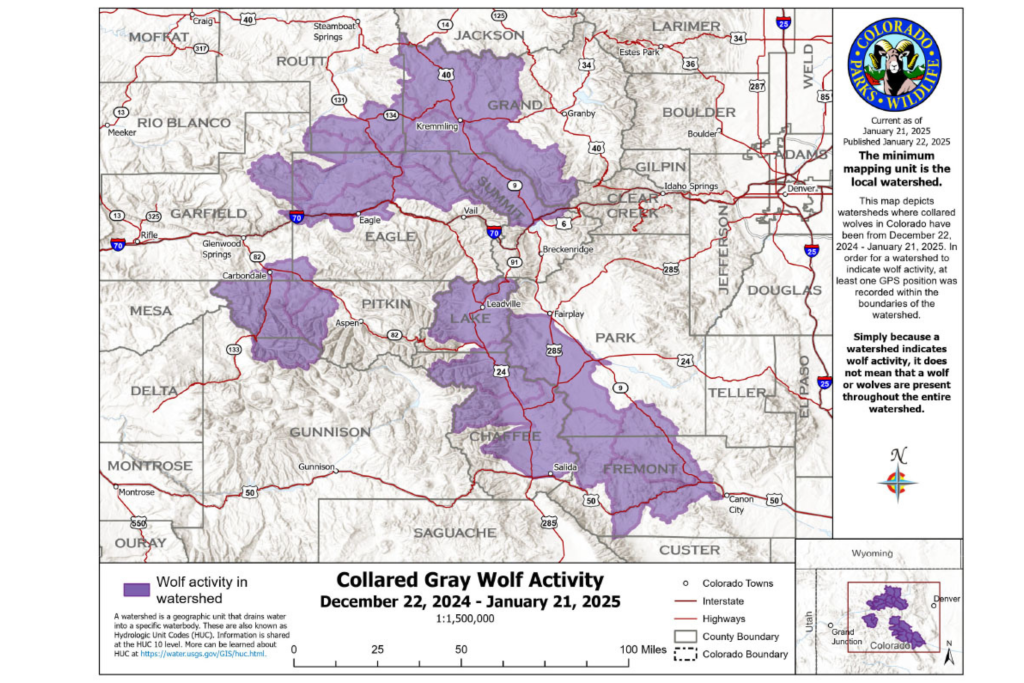The reintroduction of gray wolves to Colorado, mandated by a 2020 ballot initiative, continues to unfold with both progress and controversy. Tracking data reveals that a collared female wolf has expanded the known range of the reintroduced population, venturing further southeast than previously recorded. Her movements, primarily along watersheds in Chaffee, Park, and Fremont counties, signify the wolves’ adaptability and dispersal within the state. This expansion comes as other collared wolves remain concentrated in their initial release areas within Summit, Grand, Jackson, Routt, and Garfield counties.
This expansion highlights a key aspect of the reintroduction program’s goals: the establishment of a self-sustaining wolf population across suitable Colorado habitats. The movement of the female wolf into new territory suggests that wolves are beginning to explore and potentially settle in areas beyond their initial release zones, a positive sign for the long-term success of the reintroduction effort. However, this dispersal also brings potential challenges, especially concerning interactions with livestock and human activities in newly occupied areas.
The recent release of fifteen Canadian wolves into Pitkin and Eagle counties, west of Aspen and north of Eagle, has further fueled the debate surrounding the reintroduction program. While this action aims to bolster the genetic diversity and overall viability of the wolf population, it has drawn sharp criticism, notably from some Republican members of Congress. Their primary concern centers on the importation of “foreign wolves,” arguing for federal intervention to halt the practice. This opposition underscores the complex political landscape surrounding wolf reintroduction, with differing viewpoints on the source of the wolves and the potential impacts on local communities.
The controversy stems from concerns about the potential impact on livestock, echoing previous tensions following initial wolf releases and subsequent livestock depredation incidents. The criticism directed at the Colorado Parks and Wildlife (CPW) reflects the anxieties of ranchers and farmers who fear economic losses due to wolf predation on their livestock. This conflict highlights the delicate balance between restoring a keystone predator and mitigating the potential negative consequences for agricultural interests. The CPW, in response, emphasizes its commitment to conflict minimization programs designed to support livestock producers and promote coexistence between wolves and livestock.
CPW has implemented a robust Conflict Minimization program to address these concerns, aiming to provide rapid response to depredation incidents and promote non-lethal methods for deterring wolf attacks on livestock. The agency has also published a comprehensive guide for livestock producers, outlining strategies and tools to reduce the likelihood of conflicts with wolves. These proactive measures underscore the CPW’s recognition of the challenges associated with wolf reintroduction and its efforts to mitigate potential negative impacts on agricultural operations. They also highlight the ongoing need for communication and collaboration between wildlife managers, livestock producers, and other stakeholders.
The ongoing debate surrounding wolf reintroduction in Colorado reflects a broader national discussion about the role of apex predators in ecosystems and their relationship with human activities. The differing perspectives on the origin of the reintroduced wolves, the potential for livestock conflicts, and the overall management of the program underscore the complex social and ecological dimensions of this issue. As the reintroduced wolf population continues to expand its range and establish a presence in new areas, ongoing monitoring and adaptive management will be crucial for navigating these challenges and ensuring the long-term success of the reintroduction effort. The future of wolf management in Colorado hinges on finding a sustainable balance between restoring this iconic predator and addressing the legitimate concerns of local communities.










